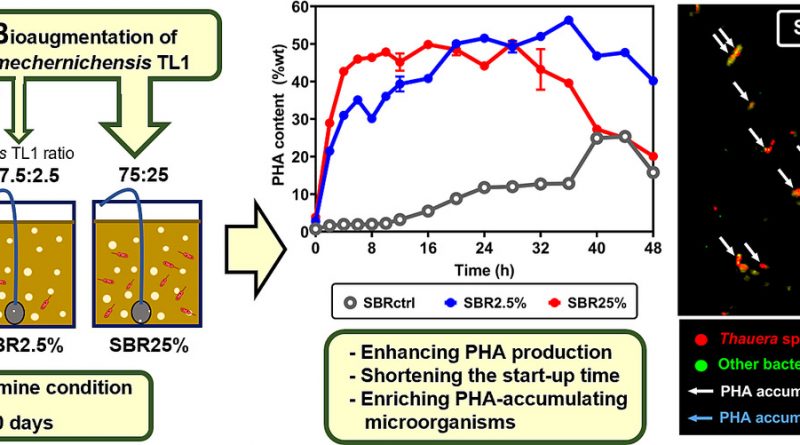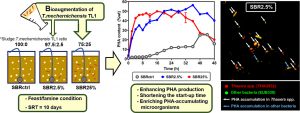Bioaugmentation of Thauera mechernichensis TL1 for enhanced polyhydroxyalkanoate production in mixed microbial consortia for wastewater treatment
Bioaugmentation of Thauera mechernichensis TL1 for enhanced polyhydroxyalkanoate production in mixed microbial consortia for wastewater treatment
การเติมจุลินทรีย์ Thauera mechernichensis TL1 เพื่อเพิ่มประสิทธิภาพการผลิตโพลีไฮดรอกซีอัลคาโนเอตในการบำบัดน้ำเสียโดยใช้จุลินทรีย์ผสม
Polyhydroxyalkanoate (PHA) is a fully biodegradable bioplastic. To foster a circular economy, the integration of PHA production into wastewater treatment facilities can be accomplished using mixed microbial consortia. The effectiveness of this approach relies greatly on the enrichment of PHA-accumulating microorganisms. Hence, our study focused on bioaugmenting Thauera mechernichensis TL1 into mixed microbial consortia with the aim of enriching PHA-accumulating microorganisms and enhancing PHA production. Three sequencing batch reactors—SBRctrl, SBR2.5%, and SBR25%—were operated under feast/famine conditions. SBR2.5% and SBR25% were bioaugmented with T. mechernichensis TL1 at 2.5%w/w of mixed liquor volatile suspended solids (MLVSS) and 25%w/w MLVSS, respectively, while SBRctrl was not bioaugmented. SBR2.5% and SBR25% achieved maximum PHA accumulation capacities of 56.3 %gPHA/g mixed liquor suspended solids (MLSS) and 50.2 % gPHA/gMLSS, respectively, which were higher than the 25.4 %gPHA/gMLSS achieved by SBRctrl. The results of quantitative polymerase chain reaction targeting the 16S rRNA gene specific to T. mechernichensis showed higher abundances of T. mechernichensis in SBR2.5% and SBR25% compared with SBRctrl in the 3rd, 17th, and 31st cycles. Fluorescence in situ hybridization, together with fluorescent staining of PHA with Nile blue A, confirmed PHA accumulation in Thauera spp. The study demonstrated that bioaugmentation of T. mechernichensis TL1 at 2.5%w/w MLVSS is an effective strategy to enhance PHA accumulation and facilitate the enrichment of PHA- accumulating microorganisms in mixed microbial consortia. The findings could contribute to the advancement of PHA production from wastewater, enabling the transformation of wastewater treatment plants into water and resource recovery facilities.
พอลิไฮดรอกซีอัลคาโนเอต (Polyhydroxyalkanoate; PHA) เป็นไบโอพลาสติกชนิดหนึ่งที่สามารถย่อยสลายทางชีวภาพได้อย่างสมบูรณ์ การผนวกการผลิต PHA เข้าสู่กระบวนการบำบัดน้ำเสียด้วยการใช้จุลินทรีย์แบบผสมจะช่วยส่งเสริมระบบเศรษฐกิจหมุนเวียน โดยการที่จะใช้แนวทางนี้จำเป็นที่จะต้องมีการศึกษาการเติมหัวเชื้อจุลินทรีย์ ดังนั้นงานวิจัยนี้มุ่งศึกษาผลของการเติมจุลินทรีย์ Thauera mechernichenensis TL1 ลงในกลุ่มจุลินทรีย์ผสมเพื่อเพิ่มปริมาณกลุ่มจุลินทรีย์ที่สะสม PHA และเพิ่มการผลิต PHA ซึ่งทำการศึกษาโดยใช้ถังปฏิกรณ์แบบกึ่งเท (sequencing batch reactor) 3 ถัง ได้แก่ SBRctrl, SBR 2.5% และ SBR 25% ภายใต้สภาวะที่มีอาหารเกินพอสลับกับขาดแคลน โดย SBR2.5% และ SBR25% เป็นการเติมจุลินทรีย์ T. mechernichensis TL1 ในปริมาณ 2.5% w/w และ 25% w/w ของปริมาณจุลินทรีย์ที่อยู่ในถังเติมอากาศ (mixed liquor volatile suspended solids; MLVSS) ตามลำดับ ในขณะที่ถัง SBRctrl ไม่มีการเติมจุลินทรีย์ T. mechernichensis TL1 ผลการทดลองพบว่าถัง SBR 2.5% และ SBR 25% มีการสะสม PHA สูงสุดคือ 56.3% gPHA/g ของปริมาณของแข็งทั้งหมดที่อยู่ในถังเติมอากาศ (mixed liquor suspended solids; MLSS) และ 50.2% gPHA/gMLSS ตามลำดับ ซึ่งสูงกว่าในถัง SBRctrl ที่มีการสะสม 25.4%g PHA/gMLSS ผลของการวัด T. mechernichensis ด้วยวิธี Real Time PCR (Quantitative Real Time PCR; qPCR) กับยีน16S rRNA พบว่าความหนาแน่นของเชื้อ T. mechernichensis ในถัง SBR 2.5% และ SBR 25% สูงกว่าในถัง SBRctrl ในรอบการเลี้ยงที่ 3, 17, และ 31 นอกจากนี้เทคนิค Fluorescence in situ hybridization และการย้อมสี PHA ด้วย Nile blue A ยืนยันการสะสม PHA ใน Thauera spp. การศึกษาวิจัยนี้แสดงให้เห็นว่าการเติมจุลินทรีย์ T. mechernichenensis TL1 ที่ 2.5% w/w MLVSS เป็นวิธีที่มีประสิทธิภาพในการเพิ่มการสะสมของ PHA และส่งเสริมการเจริญเติบโตของจุลินทรีย์ที่สะสม PHA ในสภาวะที่มีจุลินทรีย์ผสม การค้นพบนี้ทำให้เกิดความก้าวหน้าได้การผลิต PHA จากน้ำเสีย ซึ่งจะเป็นการส่งเสริมการเปลี่ยนจากระบบบำบัดน้ำเสียเป็นระบบดึงคืนทรัพยากร
สนับสนุน SDGs เป้าหมายที่ 6 : การจัดการน้ำและสุขาภิบาล ข้อย่อย 6.3 ปรับปรุงคุณภาพน้ำ โดยการลดมลพิษ ขจัดการทิ้งขยะและลดการปล่อยสารเคมีอันตรายและวัสถุอันตราย ลดสัดส่วนน้ำเสียที่ไม่ผ่านกระบวนการลงครึ่งหนึ่ง และเพิ่มการนำกลับมาใช้ใหม่และการใช้ซ้ำที่ปลอดภัยอย่างยั่งยืนทั่วโลก ภายในปี 2573


